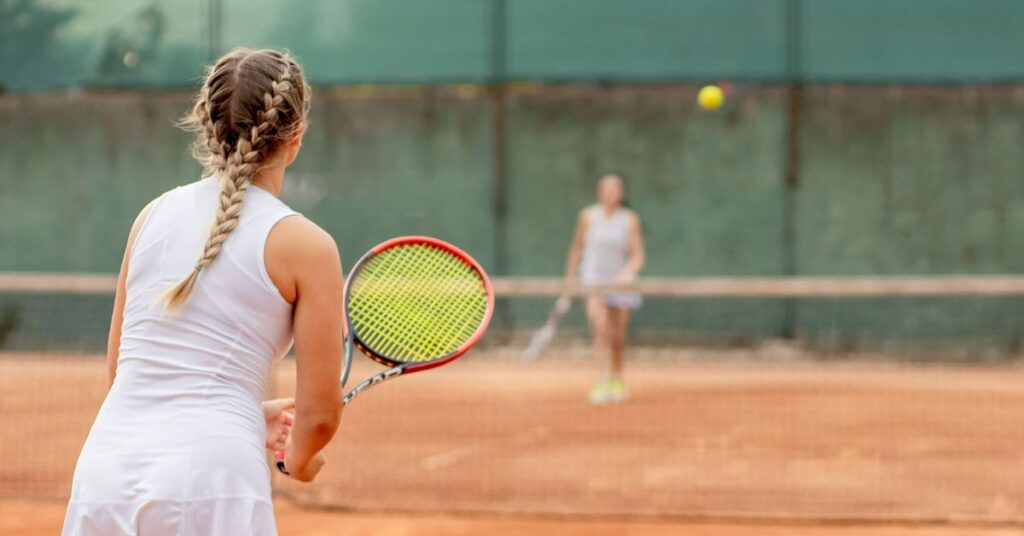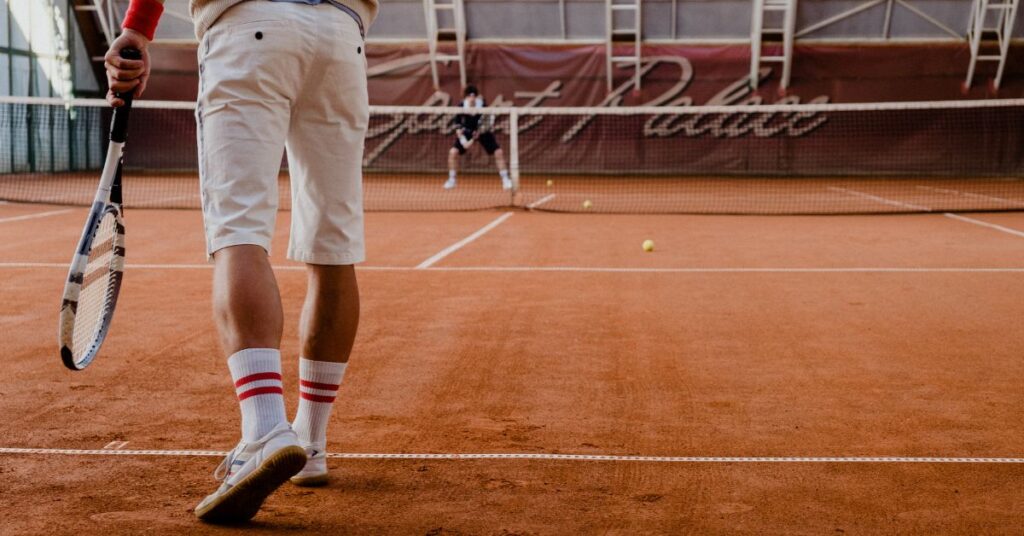I still remember the first time I stepped onto a tennis court. The sun was shining, the court was empty, and I was holding a borrowed racquet that felt both exciting and intimidating. Like many others, I was eager but clueless. That’s when I started looking into tennis basics for beginners, hoping to build a strong foundation and enjoy the game without feeling lost.
If you’re here, chances are you’re in the same boat—curious, maybe a little nervous, and looking for real, practical advice to help you get started. The good news? You don’t need to be a natural athlete to fall in love with tennis.
You just need the right mindset, equipment, and guidance. That’s what I’ll share with you today: my own experience mixed with useful tips about tennis basics for beginners that can help you step onto the court with confidence.
Table of Contents for Tennis Basics for Beginners
Why Tennis?
Before diving into techniques, let’s talk about why you might want to play tennis. For me, it was the perfect blend of physical activity and mental strategy. Unlike some sports that rely purely on brute force or speed, tennis challenges your body and your brain. Whether you’re playing singles or doubles, you’re constantly thinking ahead, adjusting your position, and anticipating your opponent’s next move.
Plus, tennis is a lifelong sport. You can start at any age, and once you learn the tennis essentials for beginners, it’s easy to progress and find others to play with at your skill level.
Getting the Right Gear
When I first started out, I made the mistake of buying the cheapest racquet I could find. It wasn’t a total disaster, but it definitely didn’t help. A beginner-friendly racquet can make a huge difference in how you learn and enjoy the game. Here’s what I recommend:
- Racquet: Look for a lightweight model with a large head size (over 100 square inches). This gives you a bigger sweet spot and helps you connect with the ball more easily.
- Shoes: Tennis-specific shoes are a must. They’re designed for lateral movement and will save your knees and ankles.
- Balls: Use beginner or low-compression balls at first. These bounce lower and slower, giving you more time to react and practice technique.
- Clothing: Wear breathable, moisture-wicking clothes. Comfort and flexibility are key.
Trust me—investing a little extra in gear tailored to a tennis guide for beginners will make your learning curve much smoother.
Understanding the Court and Scoring
The tennis court might look confusing at first, especially when you’re trying to keep up with strange scoring like “love,” “deuce,” and “advantage.” I was totally baffled the first time someone explained it to me, but don’t worry—it makes sense with practice.
Here’s a quick breakdown:
- Court Lines: Singles matches use the inner sidelines; doubles use the outer ones. The baseline is where you stand to serve.
- Scoring: Points go 15, 30, 40, and then game. If both players reach 40, it’s deuce. From there, you need two consecutive points to win the game.
Learning how to keep score and where to stand is part of the tennis fundamentals for beginners, and the more you play, the more natural it will feel.
Mastering the Basic Strokes
Now let’s get into the heart of the matter—how to actually hit the ball. There are four main strokes you’ll need to focus on when learning tennis basics for beginners:
1. Forehand
This is usually the first stroke people learn. Stand sideways, swing low to high, and aim to brush up on the ball with a relaxed grip. I practised this for hours against a wall before I felt confident.
2. Backhand
This one is trickier. You can use one or both hands—try both to see what feels better. Rotate your shoulders and follow through with your swing. Don’t worry if it feels awkward at first. It took me weeks to get mine consistent.
3. Serve
Serving is its own beast. The toss is everything—too far forward or back, and you’ll struggle. Practice your toss every day, even without hitting the ball. Serving was the hardest part of tennis basics for beginners for me, but with repetition, it does get easier.
4. Volley
Volleys are short shots near the net, great for quick points. The key is to keep your racquet up and react fast. I found that playing mini-tennis or warm-up games really helped with improving my net play.
These are the essential shots in tennis that will form the base of your skill set and give you the confidence to play longer rallies and matches.
Building Consistency
Once you have a grip on the basic strokes, the next step is consistency. Anyone can hit a great shot once, but repeating it under pressure is another story. When I first started, I’d hit three good balls and then completely miss the fourth.
The solution? Repetition and drills.
Some beginner-friendly drills I loved:
- Forehand-to-forehand rally with a friend.
- Shadow swings to improve muscle memory.
- Serve practice into a specific target area (use cones if you want).
These drills helped me reinforce the tennis tips for beginners I picked up through online tutorials, coaches, and fellow players.
Positioning and Footwork
If I could go back and give myself one piece of advice when I started, it would be this: never ignore footwork. Tennis is a game of movement as much as technique. You can have the best stroke in the world, but if you’re out of position, it won’t matter.
Key tips:
- Split step before your opponent hits.
- Stay on the balls of your feet.
- Recover to the middle after each shot.
I used to stand flat-footed and reach for the ball, and it totally threw off my balance. Once I worked on footwork, my entire game improved. That’s why I always include positioning as part of the essential tennis for beginners checklist.
Mental Game and Confidence
Let’s be honest—starting something new can be intimidating. When I joined my first tennis clinic, I was nervous about looking silly or messing up. But everyone starts somewhere, and most players are supportive and understanding.
Here’s what helped me:
- Set small goals: Aim to get 10 forehands in a row or land 5 serves in.
- Celebrate progress: Every improvement counts.
- Don’t compare yourself to others. Everyone learns at their own pace.
Remember, learning tennis basics for beginners isn’t just physical—it’s a mental journey too. Stay positive and be patient with yourself.
Practicing on a Budget
You don’t need a country club membership to play tennis regularly. I found so many affordable ways to improve my game and enjoy time on the court:
- Local parks often have free courts.
- Community meet-ups can connect you with practice partners.
- Wall drills and shadow swings cost nothing but time.
Even hitting balls alone or doing fitness routines helped me improve your game gradually, and before I knew it, I was rallying confidently.
Playing Your First Match
The first match I played was full of nerves, missed shots, and unexpected rallies. But it was also incredibly rewarding. I started to appreciate the flow of games sets matches tennis, and how thrilling it is to score a winning shot.
Don’t put too much pressure on yourself to win right away. Focus on keeping the ball in play, using your footwork, and having fun. Every match teaches you something new, and even your losses help you grow.
More about Tennis Basics for Begginers
What Are the Basic Rules of Tennis for Beginners?
When I first started playing, the rules felt like a foreign language—what’s “love,” and why are we going from 15 to 30 to 40?! But honestly, it’s a lot simpler than it seems once you get the hang of it. Here’s what helped me:
- Scoring goes 15, 30, 40, then game. If both players get to 40, it’s called deuce, and you need to win two points in a row to win the game.
- Matches are made up of sets, and sets are made up of games. The first to 6 games usually wins a set, but you have to win by two.
- You serve diagonally across the court, and the ball has to land in the service box. Miss twice, and it’s a double fault—point goes to your opponent.
- Only one bounce is allowed before you return the ball.
- If the ball lands on the line, it’s in. That saved me a few times!
When you break it down, the rules are there to keep things fair and flowing. Once I played a few sets, everything started to click.
How Can I Teach Myself to Play Tennis?
Honestly, I’m a huge fan of the DIY approach—especially when you’re just dipping your toes in. I taught myself the basics with a mix of YouTube tutorials, drills against a wall, and lots of trial and error. Here’s what worked for me:
- Start with a wall. It doesn’t judge you, it’s always available, and it gives you constant practice. I must’ve spent hours hitting forehands and backhands off a brick wall.
- Watch slow-motion videos. Seeing pros hit a forehand in super slow-mo helped me understand grip, swing path, and footwork way better than just reading about it.
- Film yourself. I cringed the first time I saw my swing, but it helped me fix my grip and follow-through faster.
- Use beginner balls. Slower and lower bounce means more control. Trust me—it makes learning so much smoother.
- And most importantly, be patient. You don’t need to hit like Federer to enjoy the game.
Self-teaching isn’t always easy, but it’s incredibly rewarding. Every little improvement feels like a win.
What Is the First Thing to Learn in Tennis?
For me, the first and most crucial thing was how to hold the racquet properly. I didn’t even know there were different grips! Once I learned the continental grip (used for serves and volleys) and the semi-western grip (great for forehands), my shots started to feel way more controlled.
Right after that, it was all about getting the swing motion down—specifically low-to-high on the forehand and backhand. I practiced that motion without even hitting a ball at first, just shadow swings in the driveway.
It’s tempting to jump straight into matches, but taking the time to get that first step right—grip and swing basics—lays a solid foundation for everything else. It’s like learning the alphabet before writing sentences.
What Are the Basic Tennis Steps?
When I first heard “tennis steps,” I thought it was some secret footwork trick. Turns out, it’s more about the rhythm and movement you use for each shot. Here’s how I break it down in my head:
- Ready position – Knees bent, racquet out in front, eyes on your opponent.
- Split step – This tiny hop you do right before your opponent hits the ball. It helps you react faster. It felt weird at first, but now it’s second nature.
- Move to the ball – Quick side steps or shuffle steps to get into position. Don’t just reach—move your feet!
- Set up your shot – Rotate your shoulders, keep your non-dominant hand up to track the ball, and prepare to swing.
- Swing and follow through – Smooth, controlled swing with your body weight shifting forward.
- Recover – Don’t stand and admire your shot! Get back to the middle and reset for the next one.
Those basic steps completely changed how I moved on the court. Once I focused more on my footwork than just swinging wildly, my consistency skyrocketed.
The Top Mistakes You Make on Your STROKES When Starting Out in Tennis
Final Thoughts
Learning tennis isn’t always easy, but it’s always rewarding. The sport has brought me joy, fitness, new friendships, and even a few healthy rivalries. If you’re just getting started, embrace the challenge. The path from beginner to confident player is paved with small victories, consistent practice, and a good dose of patience.
By sticking with the core tennis basics for beginners, you’ll not only build strong technical skills—you’ll also develop a love for the game that lasts a lifetime. Whether you’re perfecting your swing for beginner players or just figuring out where to stand, remember that every bit of progress counts.
And who knows? Maybe one day you’ll be the one giving advice to someone picking up a racquet for the first time.









